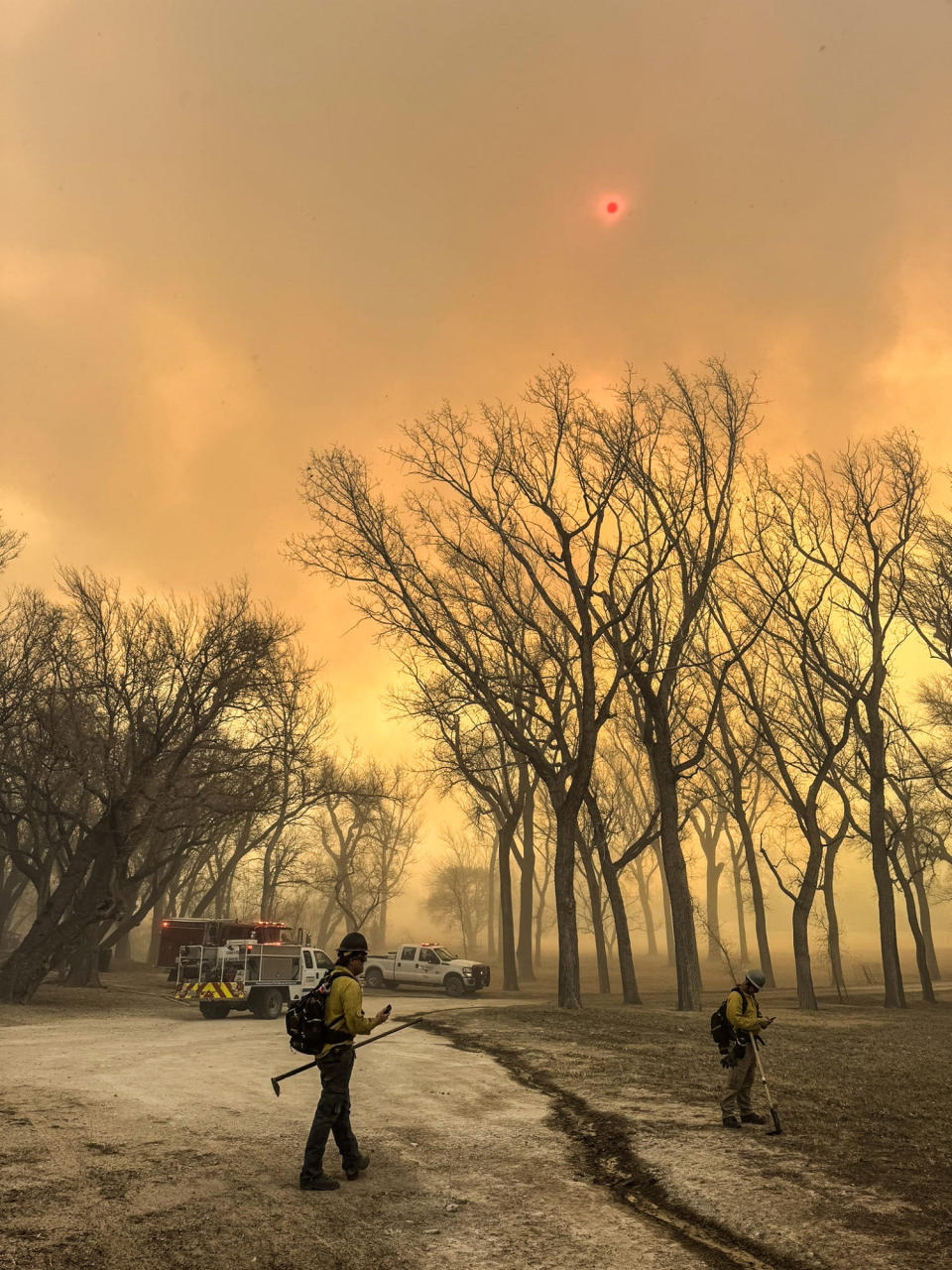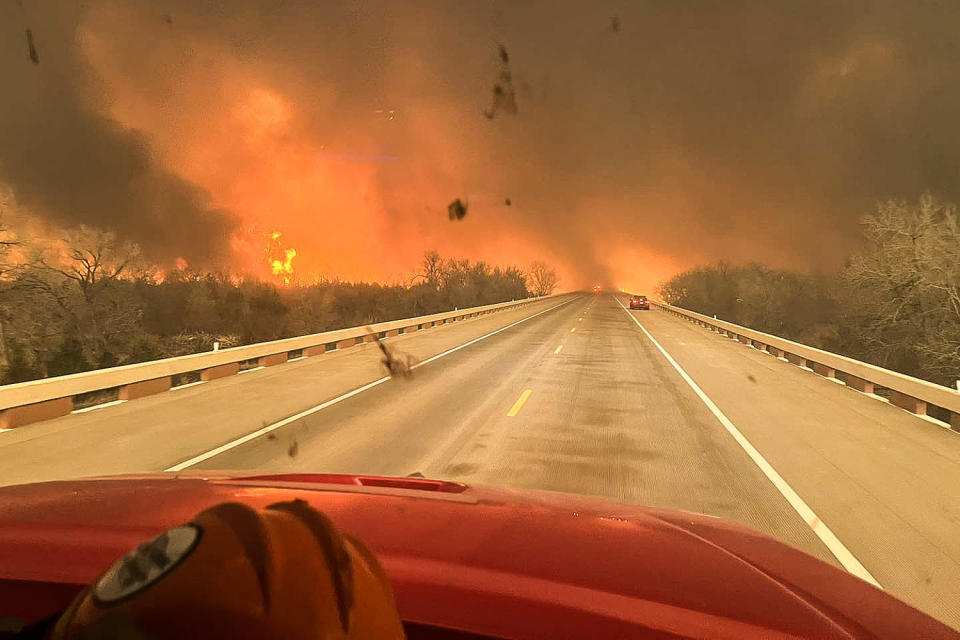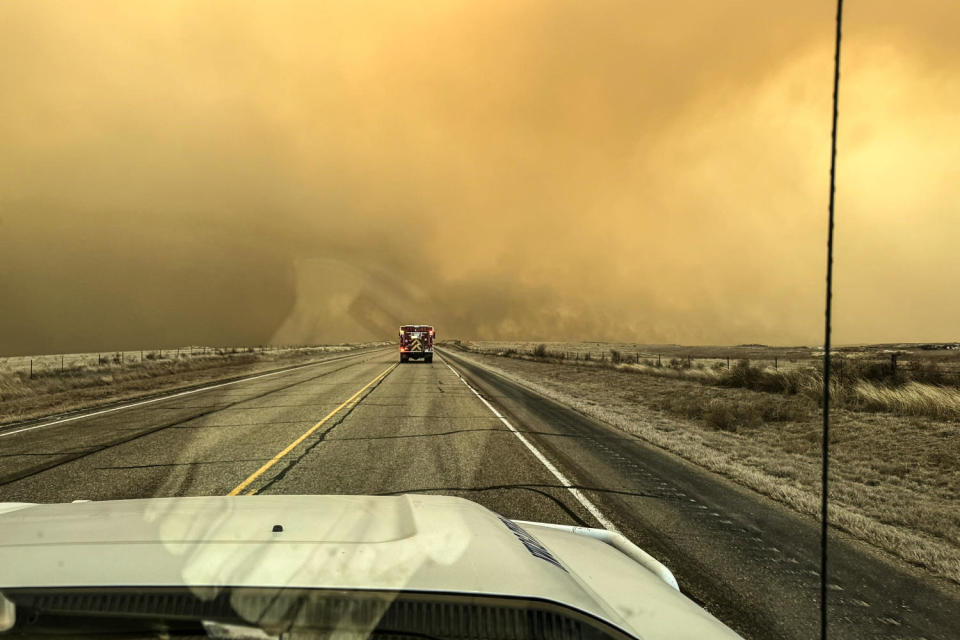Abnormally high temperatures, dry grass and a windy cold front combined to create the conditions for the devastating wildfires that ripped through parts of Texas this week.
The winds sending wildfires across the Texas Panhandle came at the perfect time of day for destruction, “like a hurricane making landfall at high water,” said Texas State Climatologist John Nielson-Gammon. He added that hot, dry temperatures, such as those that could be triggered by climate change, help create conditions for fires to break out.
Temperatures reached the mid-80s in parts of the state’s dry north Monday and several wildfires began burning.
The next day, Arctic air descended from the north in a harsh cold front. Nielsen-Gammon said winds on both sides of that front — sometimes exceeding 50 miles per hour — were sending flames roaring through dormant grass. The cold front arrived in the afternoon, when wind speeds were highest, and changed direction as it passed, maximizing the rate of fire spread.
It is unclear how the fires started.

“The timing of the weather during the day was probably the worst possible time,” Nielsen-Gammon said. “If you’re going to have a wildfire outbreak, this is the kind of weather pattern that will do it.”
The fires spread so quickly that firefighters had little chance of getting the blaze under control.
“All things considered, these fires were moving very quickly for a wildfire. “We saw speeds in the 5-10 mph range,” said Christian Rangel, meteorologist for the National Weather Service in Amarillo. “The strong winds really helped push these guys out and get to an uncontrollable situation.”
The terrain of the area also played a role, as open land helped control fires and spread quickly, but also made fighting fires more difficult.
Although mostly flat, the area is characterized by sandy and grassy “bad terrain” that can be difficult to access, said Luke Kanclerz, chief of the Texas A&M Forest Service’s forecasting services department. Therefore, when fires engulfed the plains, they quickly became difficult to control.
“A fire moving at about 5 miles per hour may not sound very fast, but if you have a large fire front and you’re trying to contain a large area, it greatly outpaces fire suppression efforts,” Kanclerz said.
The Texas Panhandle is no stranger to high winds or sudden drops in temperature. But the fires wouldn’t have the same chance of going out if it weren’t for the above-normal temperatures and dry conditions that climate change has made more likely.
“This particular event would have been less devastating if it had occurred during the same period several decades ago,” Nielsen-Gammon said. “These high temperatures can occur early in the season and occur when grasses are normally dormant, so there is plenty of dry fuel available.”
John Abatzoglou, a climate scientist at the University of California, Merced, said wind was the biggest factor in the size of the fires, which covered nearly 1 million acres, according to the federal wildfire tracking site Inciweb.
“This is primarily a wind-driven fire,” Abatzoglou said, adding that the role of climate change is “more subtle than we generally think.”
Abatzoglou said the wind initially came from the west and spread the fires in an ellipse across the map, then shifted about 90 degrees and began pushing those lines southward.
Abatzoglou said there is little concrete evidence of how climate change is changing wind speeds.
Temperatures in the Borger area near where the fires broke out reached 85 degrees F on Monday, according to National Weather Service data.
“We broke records for most of our climate sites,” Rangel said of the Amarillo forecast area, adding that relative humidity readings were at or below 20% in many parts of the state and the land was ripe for burning.


Parts of the Texas Panhandle are abnormally dry, according to the National Drought Monitor, but the landscape is not suffering from severe drought. It actually received a healthy dose of precipitation in late summer and fall, which helped the grass grow taller.
Above-normal growth has increased the risk of wildfire during what is considered Texas’ dormant season for grasses, which typically runs through the winter until mid-April.
Nielsen-Gammon said the warmth comes early in the season and before vegetation greens up and becomes less likely to burn.
“This time we didn’t need drought to get dry fuel,” Nielsen-Gammon said. “We are in the dormant period of the grass, there is still dead grass around.”
Fire weather is becoming more frequent in the Western United States. Using weather station data and measurements of temperature, wind and relative humidity, the nonprofit group Climate Central calculated how the number of fire weather days has changed in communities across the United States from 1973 to 2022.
By the end of the group’s five-decade study period, parts of Texas, including the High Plains and Panhandle, were seeing twice as many fire weather days, according to Climate Central. Additional fire days have been occurring in the High Plains for more than a month, according to the report.


Texas has a complicated future when it comes to wildfire, according to a report by Nielsen-Gammon and colleagues on the state’s future with extreme weather.
But researchers think dry conditions will extend the wildfire season, especially in places like east Texas where conditions are less dry. In the future, wildfire risk may begin to increase more slowly in West Texas and the Panhandle as plants struggle to grow in a drier climate.
Nielsen-Gammon said she is concerned that fast-moving wildfires could become more common in Central and East Texas as conditions dry, putting the Austin, San Antonio and Dallas-Fort Worth areas at greater risk.
“The risk of loss of life is greater there, and this happens in places where people are not used to wildfires,” he said.
This article first appeared on NBCNews.com.